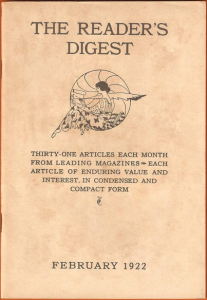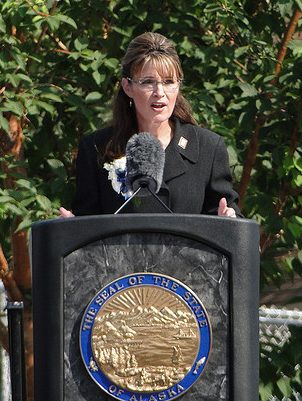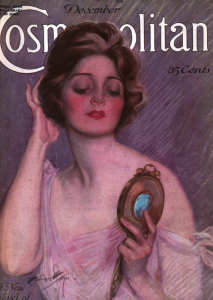5.4 Major Publications in the Magazine Industry
Magazines have undergone significant evolution since their inception. Magazines have significantly impacted the world by providing their readers with news, entertainment, literature, and photography. Additionally, the magazine industry has had a profound impact on U.S. popular culture. As magazines have evolved, individual publications have targeted specific groups and provided content tailored to particular niches. This section explores some popular periodicals and their effect on their target audiences.
High-Circulation Magazines
The top 10 highest-circulating magazines in the United States differ significantly in style and audience. From AARP to Better Homes and Gardens, from National Geographic to Family Circle, the list showcases the diverse pool of readers and interests drawn to the medium. This section will explore the top three publications: AARP The Magazine, AARP Bulletin, and Reader’s Digest.

AARP The Magazine and AARP Bulletin
Consumers cannot purchase the two magazines with the highest circulation in the United States: AARP The Magazine and AARP Bulletin. Published by the nonprofit organization AARP (formerly known as the American Association of Retired Persons), the organization sends both automatically to its more than 40 million members.
A bimonthly publication “geared exclusively towards 50+ Americans seeking to enhance their quality of life as they age (AARP),” AARP The Magazine publishes lifestyle articles. It includes sections dedicated to health, money, work, relationships, and travel, among others. Its mission statement reads:
AARP The Magazine offers three editorial versions tailored to different life stages (50–59, 60–69, 70+) to empower readers with content written specifically for them. Annual editorial packages, strong service journalism, and celebrity profiles will be presented in a warm, vibrant, and inviting format to encourage readers to reflect, engage, and enjoy (AARP).
AARP also publishes AARP Bulletin, a monthly news publication that reaches influential consumers and policymakers (AARP).” Rather than presenting lifestyle stories, this publication focuses on news stories of interest to its target audience.
The AARP Bulletin chronicles and interprets critical social issues that affect Americans aged 50 and older. News, balanced analysis, and concise stories, presented in an accessible format, motivate these influential readers to engage in public policy discussions on healthcare, financial well-being, and consumer protection (AARP).

Reader’s Digest
Reader’s Digest boasts the third-highest circulation among U.S. magazines. First published in 1922 as a “digest of condensed articles of topical interest and entertainment value taken from other periodicals (Encyclopedia Britannica),” a husband and wife team who believed the magazine would sell (despite numerous rejections from magazine publishers) first produced this famous pocket-sized journal on a low budget (Encyclopedia Britannica). They were right. Reader’s Digest became an almost immediate success and now regularly outsells competitors. The monthly magazine has subscribers around the globe and seeks to “create products that inform, enrich, entertain and inspire people of all ages and cultures around the world (Reader’s Digest).”
News Magazines
As discussed earlier in this chapter, newsmagazines became popular during the 1920s. Today, newsmagazines account for a significant portion of magazine sales, with multiple news periodicals ranking among the top 30 for circulation. Over time, several newsmagazines have established themselves in the industry, including Time, Newsweek, and U.S. News & World Report.
Newsweek
Newsweek debuted in February 1933 as News-Week and featured seven different photographs from the week’s news on its cover. The weekly publication currently “offers comprehensive coverage of world events with a global network of correspondents, reporters and editors covering national and international affairs, business, science and technology, society and the arts and entertainment (Newsweek, 2007).” Relying on a wide array of reporters, Newsweek also uniquely publishes a reader-penned section titled “My Turn.” The magazine holds more prestigious National Magazine Awards than any other newsweekly.
The magazine has had its controversies, however. In November of 2009, Newsweek published an article discussing Sarah Palin’s book, Going Rogue: An American Life. The cover of that issue featured a photo of Palin previously used in an issue of Runner’s World with her in running attire. The magazine printed the words “How Do You Solve a Problem Like Sarah?” across the photograph.

The cover caused a widespread backlash, with readers calling it sexist and unfair. One reader suggested that Newsweek would never print a photograph of Barack Obama in such attire. In response, Newsweek published a photo of President Obama in his swim trunks in its following issue, although the smaller photo ran on an inside page rather than on the cover.
Time
Time has remained an influential publication during the decades since its inception. Today, the publication prides itself on its “rare convergence of incisive reporting, lively writing and world-renowned photography,” which combined has earned it the praise of being “journalism at its best (Time).” The magazine divides itself into four main sections: Briefing, The Well, Life, and Arts. Briefing includes concise stories on major news events in the United States and other countries. The Well section features longer articles, including the cover story and pieces on world and business topics. Life contains stories on health, science, technology, and the environment. Finally, Arts consists of reviews of theater, film, literature, music, exhibits, and architecture. Like Newsweek, Time has won numerous awards and prides itself on being “the guide through chaos” in an era of information overload (Time).
U.S. News & World Report
Created through the merger of a newspaper and a magazine, U.S. News & World Report has gained great prestige over the years. In 1933—the same year that Newsweek debuted—journalist David Lawrence began publishing a weekly newspaper called the United States News. Six years later, he founded a weekly magazine titled World Report. In 1948, the two weeklies merged to create the new U.S. News & World Report. The magazine’s focus appears similar to those of Time and Newsweek. Still, U.S. News & World Report concentrates more on political, economic, health, and education stories, perhaps in part because it is based in Washington, DC. Although the magazine had published weekly for most of its long history, in 2008 it announced its transition to a monthly printing schedule, vowing to concentrate on its website.
Audiences are most likely familiar with the magazine due to its annual ranking of U.S. colleges. This ranking began in 1983 and has since evolved to include newsstand books of America’s Best Colleges and America’s Best Graduate Schools. Since the ranking system began, students have turned to the publication for information about the strengths and weaknesses of colleges and universities.
Women’s Magazines
Female readers have provided a strong foundation for the magazine industry since the early 19th century, initially because women traditionally did not serve in the workforce and were perceived to have more leisure time to read. This lucrative market has continued to grow over time. In an increasingly online era, many magazines have sought ways to expand their scope to reach a larger audience. Yet others, such as Good Housekeeping and Better Homes and Gardens, have maintained their original scope and continue to turn a profit. These two periodicals represent part of the “Seven Sisters,” a group of magazines traditionally targeted at female audiences.
Good Housekeeping
In May of 1885, Good Housekeeping began publishing to provide “information about running a home, a broad range of literary offerings, and opportunities for reader input (Library of Congress).” Fifteen years later, the magazine founded the Good Housekeeping Research Institute. The research institute features a product-evaluation laboratory where a team of scientists, engineers, nutritionists, and researchers assess a diverse range of products. The magazine then reports its findings to its readers to “improve the lives of consumers and their families through education and product evaluation (Good Housekeeping).” The magazine describes itself as:
Devoted to contemporary women. Monthly articles focus on food, fitness, beauty, and childcare using the resources of the Good Housekeeping Institute. From human interest stories and social issues to money management and travel, the magazine will encourage positive living for today’s woman (Good Housekeeping Magazine, 2010).
Like many magazines, Good Housekeeping has expanded its online offerings.
Better Homes and Gardens
Making its print debut in 1922, Better Homes and Gardens entered the industry later than its counterparts. Since its inception, the publication has focused on home and gardening style and decorations. Its positioning statement reads:
For the woman who reads Better Homes and Gardens, home is where she creates her life story. It’s her haven, where she raises her family, entertains friends, and celebrates life’s big and small accomplishments. It’s where she indulges her dreams and builds a world of her own. Home is her emotional center—it’s where life happens. Better Homes and Gardens recognizes this and inspires her with infinite possibilities for creativity and self-expression. Each issue delivers smart, approachable editorials on design and individual style, decorating and gardening, food and entertaining, as well as personal and family well-being. Better Homes and Gardens helps her bridge the gap between dreaming and doing (Meredith).
The monthly magazine divides itself into six sections: Food and Nutrition, Home, Health, Family, Gardening, and Lifestyle.
Cosmopolitan

First published in 1886, the female-targeted Cosmopolitan has undergone significant changes over time, evolving from its original intent as a “first-class family magazine” to one that recognized the need to cater to a previously overlooked audience: sexually liberated women (Mott, 1957). In the first issue, the editor told readers that “there will be a department devoted exclusively to the interests of women, with articles on fashions, on household decoration, on cooking, and the care and management of children, etc., also a department for the younger members of the family (Mott, 1957).” Just two years later, however, the original publishing company went out of business, and after several publisher changes, newspaper mogul William Randolph Hearst eventually purchased Cosmopolitan in 1905.
The magazine became more successful during the 1960s when Helen Gurley Brown “transformed an antiquated general-interest mag called Cosmopolitan into the must-read for young, sexy single chicks (Benjamin).” Brown transformed the magazine from a family-focused publication to a somewhat controversial read with an emphasis on sex, work, and fashion. The magazine describes the transformation, saying:
Over the years, Cosmo has not only become the number-one-selling monthly magazine on the newsstand, but it has also served as an agent for social change, encouraging women everywhere to go after what they want (whether it be in the boardroom or the bedroom) (Benjamin).
In 1965, Cosmopolitan revamped its journal with Brown’s vision in mind. The first retooled issue had an article about birth-control pills, then a relatively new and controversial innovation. The magazine’s provocative articles attracted a large readership, but many found it offensive. Conservatives decried the content as too racy, while some feminists thought it focused too heavily on beauty and pleasing men (Benjamin). Yet the publishers of Cosmopolitan believed that they introduced a new form of feminism (Benjamin). Brown argued that “Cosmo is feminist in that we believe women are just as smart and capable as men are and can achieve anything men can. But it also acknowledges that while work is important, men are too. The Cosmo girl absolutely loves men (Benjamin)!”
Today, Cosmopolitan continues to attract readers by upholding the same ideals that Brown introduced in the 1960s. The magazine dedicates nearly 30 percent of every issue to relationships, especially sex. The rest provide articles on beauty, fashion, entertainment, health and fitness, and self-improvement.
Celebrity Magazines
Often criticized at times for their less-than-sophisticated approach to journalism, celebrity magazines generate enormous profits and help shape U.S. pop culture, fueling the obsession some Americans have with the mundane, day-to-day details of celebrity lives. Three of the most prominent celebrity magazines currently publishing include People, OK!, and Us Weekly.
People
People first began publishing as a spin-off of Time magazine’s “People” section in 1974. The publication distinguishes itself from other celebrity gossip magazines by featuring human-interest stories of everyday people alongside photos and articles about celebrities. The publishers of People state that they avoid pure Hollywood gossip articles and refuse to publish stories without some verification (Moni). This editorial slant sets the publication apart from other celebrity magazines, and as such, it frequently receives exclusive interviews and photo shoots with celebrities. The somewhat more respectful relationship between the publishers and some celebrities has helped People become the most popular celebrity magazine in circulation.
OK!
A British-run magazine that began publishing in 1993, OK! claims to “bring you the truth and the inside scoop about celebrities (OK Magazine).” Known for its exclusive interviews that often lead to public announcements on pregnancies and engagements, OK! initially had a policy to print only positive celebrity profiles (Search). That policy changed in 2007 thanks to an erratic interview with pop singer Britney Spears, which was so surprising that the magazine decided to break with tradition and publish it anyway (Search). In 2008, Spears agreed to a second interview with the publication in which she discussed her previous behavior, leading to a more positive profile of the singer. The widely successful magazine has readers worldwide, along with several branch publications.
Us Weekly
Founded in 1977, Us Weekly followed a bimonthly format as an entertainment news and review magazine until 2000, when it transitioned to a weekly format, becoming a leader in celebrity news and style. The publication “delivers a mass audience of young, educated, and affluent adults who are compelled by breaking celebrity news, Hollywood style, and the best in entertainment (Us Weekly).” Us Weekly has become known for its fashion sections, such as “Who Wore It Best?,” a reader poll comparing two celebrities wearing the same outfit, and “Fashion Police,” in which comedians comment on celebrity fashion mishaps and successes.

